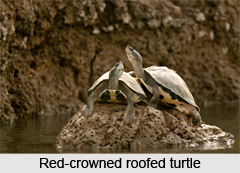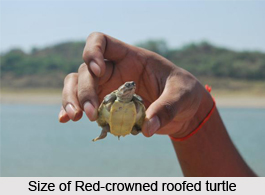 Red-Crowned Roofed Turtle is an Indian Reptile that bears a scientific name "Batagur kachuga" is a species of freshwater turtle endemic to South Asia.
Red-Crowned Roofed Turtle is an Indian Reptile that bears a scientific name "Batagur kachuga" is a species of freshwater turtle endemic to South Asia.
Category of Red-Crowned Roofed Turtle
Red-Crowned Roofed Turtle was the type of species of its former genus Kachuga.
Size of Female Red-Crowned Roofed Turtle
The female Red-Crowned Roofed Turtle can grow to a shell length of 56 cm (22 in) and weighs 25 kilograms (55 lb), but males are considerably smaller.
Behaviour of Red-Crowned Roofed Turtle
Red-Crowned Roofed Turtle like to bask in the sun on land. In the breeding season, the heads and necks of male turtles exhibit bright red, yellow and blue colouring. The females excavate nests in which they lay clutches of up to thirty eggs.
Concentration of Red-Crowned Roofed Turtle
Red-Crowned Roofed Turtle was found in central Nepal, north-eastern Indian states like Assam, Gwahati, Shillomg, Meghalaya, Tripura, Bangladesh and probably Burma, but it has suffered declines in population due to being harvested for meat and shells, drowned in fishing nets, water pollution, hydro-electric schemes and habitat loss.
Wild Red-Crowned Roofed Turtle
The fewer number of Red-Crowned Roofed Turtle is found in four hundred adult females that are thought to remain in the wild, with the International Union for Conservation of Nature rating this turtle as being "critically endangered". India has put conservation measures in place, and a captive breeding programme has been initiated.
 Structure of Red-Crowned Roofed Turtle
Structure of Red-Crowned Roofed Turtle
Red-Crowned Roofed Turtle can weigh up to 25 kilograms (55 lb) and have shells as long as 56 centimeters (22 in). Males reach only half the length of females. At the end of the rainy season, the heads and necks of male turtles develop a brilliant courtship coloration of red, yellow, white and blue, with 6 distinctive bright red stripes on top of the head.
Carapace of Red-Crowned Roofed Turtle
The carapace of Red-Crowned Roofed Turtle is strongly keeled. The keels are tubercular posteriorly on the second and third vertebral shields. The posterior margin is strongly crenulated. The marginal serrature disappears in adolescent specimens and the vertebral keel, after being reduced to a series of low knobs, vanishes entirely in the full-grown, the carapace of which is very convex. The nuchal shield is small, trapezoidal and broadest posterior. The first vertebral is as broad or broader in front as behind. The second vertebral is longer than the third, with which it forms a straight transverse suture. The fourth is longest and forms a broad suture with the third. The second vertebral is broader than long in the young, and as long as broad in the adult. Plastron is angulate laterally in the young. The anterior and posterior lobes are rather narrow and shorter than the width of the bridge, truncate anteriorly and are openly notched posteriorly. The longest median suture is between the abdominals and the shortest is between the gulars, which equals about one half that between the humerals. The suture between gulars and humerals forms an obtuse angle, as does that between humerals and pectorals. The inguinal is large and the axillary is smaller.
Head of Red-Crowned Roofed Turtle
The head of Red-Crowned Roofed Turtle is moderate sized with an obtuse and moderately prominent snout. The jaws have denticulate edges with the upper not notched mesially. Alveolar surfaces are very broad, the median ridge of the upper jaw being somewhat nearer the outer than the inner margin. Choanae are behind the line of the posterior borders of the orbits. The width of the lower jaw at the symphysis equals the diameter of the orbit. The limbs have transversely enlarged, band-like scales which are coloured brown above and yellowish below. The nape has red longitudinal lines.
Habitat of Red-Crowned Roofed Turtle
The National Chambal Sanctuary portion of the Chambal River has received moderate protection since 1979 as India"s only protected riverine habitat. It is believed to be one of the last viable habitats for this species, though even here, B. Kachuga are rare.



















